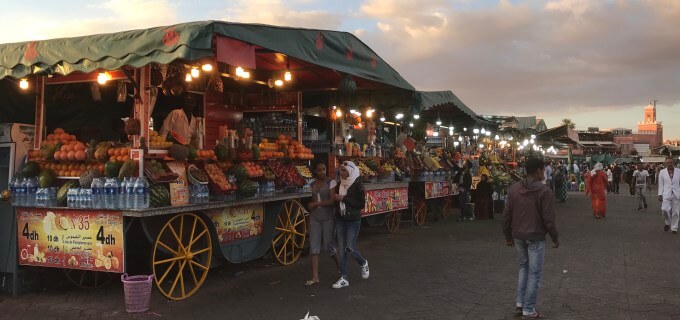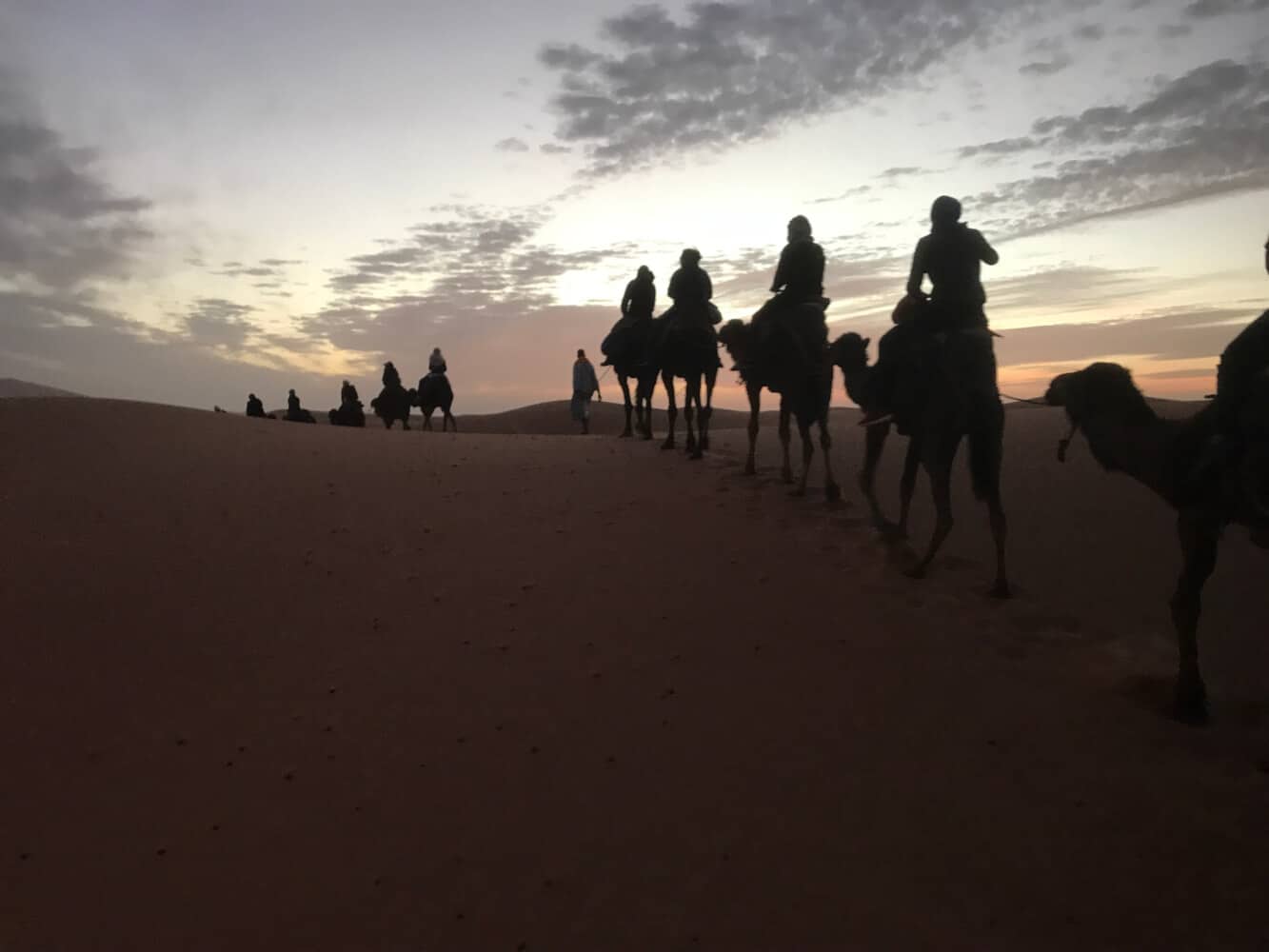“Hello Friend! Where are you from?”
Tourists in Marrakech, Morocco hear this in every crowd. First arrivals may marvel at the native young men’s friendliness and ability to speak English well. A seasoned and wary traveler quickly sees the scam brewing. In a city full of tourists, strangers rarely take interest in you, but often take interest in your wallet.
Small manufacturers can learn advanced pricing tactics from Moroccan shop owners, many of whom have been in business over 500 years. Here’s a summary of the best tactics I observed.
Know your target market.
The question, “where are you from?” serves two-fold: it engages you to talk about yourself (establishing trust) and it tells the seller how wealthy you are.
“America?! Oh, Kendrick Lamar! Very good! You look for purse for wife? My family give you good deal…”
Since I was being asked this question repeatedly, I started answering with different countries for fun. The kids will put more or less effort into selling me depending on where I am from and how much money they think they can get from me. Saying “America” or “Japan” is like saying “I’m filthy rich and willing to spend money,” whereas saying “Bolivia” means they’ll quickly leave me alone. Somewhere in between is China, Brazil, and Russia.
Pricing lesson #1: know your target market. These kids do, and they don’t waste time with low-value customers.
Cost based pricing is ancient.
I repeated the same “where are you from?” experiment at shops (souq’s) selling identical leather purses made in Marrakech. Here’s the asking prices I was quoted:
- American: $600 Dh
- Spaniard: $500 Dh
- Chinese: $450 Dh
These are identical purses bought wholesale from the same factory for the same cost, but the price varies depending on the consumer. Fluctuating prices are an uncomfortable idea for Americans spoiled on fixed pricing. The fact is, up until the last 150 years, fluxuating pricing was THE ONLY WAY to do business. Small manufacturers know this world and live or die by pricing off the customers’ willingness to pay, not just cost + margin. (If you are a manufacturer who doesn’t know what I’m talking about, I guarantee your competition is leaving you in the dust.) The shop owners of Marrakech understand this too. Some people are simply willing and able to pay more, so why not charge more? This is a well-studied economic phenomena called “price differentiation.” Business that achieve this are always more profitable.
Pricing lesson #2: price based on need, not cost.

Raise prices to sell more units…?
Marrakech Medina (old town) is centered around a square called Djemaa El Fna, where thousands gather nightly for food, music, and shopping. Souq’s border Djemaa El Fna and spiral out in labarynthian passageways romanticized by Hollywood and travelers. As I wandered through these dark, narrow walkways full of tiny souqs selling silver jewelry, rugs, and brass lanterns, I wondered how a shop’s location affects its price. Below are the prices I was quoted for the same leather purse based on location:
- On the edge of the square: $600 dh
- 1/4 mile from the square: $575
- On the fringes of Medina: $500
- In the mountains outside Marrakech: $300
- In a leather cooperative outside Medina: $1000
Why would anyone buy from the leather cooperative? Two reasons. First, most tourists do not comparison shop. While perfect information is a useful assumption for economists, small retailers know it is unrealistic. Why not use it to your advantage? The cooperative was doing plenty of volume despite being twice as expensive as their competition.
Second reason: their value proposition was more than just a leather purse. They market their traditional and sustainable practices, natural dyes, and offer a free tour of the tanneries; all of which empowered consumers to consciously pay more and feel better about it! Remember, there is a psychology to pricing.
Pricing lesson 3: High price does not mean less volume. When done right, it means more volume.
Commodity hell
As a final thought, take a look at the juice sellers in this puncture:

The man in the juice stall was shouting, gesturing, offering free samples, and doing anything he could to sell a glass of $0.40 orange juice. Why work so hard for so little? Because he had four juice stands next to him doing the exact same thing. Juice is a commodity in Djemaa. This means every juice seller had identical products for identical rock bottom prices. If he raised his price a single cent, he would lose all the customers to the neighboring stands. Similarly, if he lowered his price a single cent, his competition would match and he would sell no additional units.
Consider how different the pricing market is between the juice seller and leather shops. The former is powerless, the latter has tremendous pricing power. How could juice stands become less a commodity by differentiating themselves? Offer a yougurt-mixed drink? Move to a different location? Provide seating for customers? Offer snacks? Anything seemed easier than the desperate sales tactics they were employing.
This is an obvious problem when we look at juice stalls, but the same d0emon lurks in the shadows of contract manufacturing. In that world the market is less transparent due to global competition and fewer customers, a considerably harder situation than selling juice in a square. Commodity services like CNC machining or injection molding are under these tough pricing pressures, and owners often find themselves desperately yelling at customers to try their $0.40 orange juice.
Just like the juice stand has options, so does the small manufacturer. Investing in technology, automation, talent, or customer relationships are classic ways to differentiate. They also have considerably higher barriers to entry than adding yougurt to a juice stall. The best solution is one that suits your industry, your strengths, and your competitions weakness. A strategic planning session is the place to start.
Pricing Lesson #4: stay out of commodity hell. Differentiate your product, and build barriers to entry.
Moroccan Pricing Lessons for Small Manufacturers
You have pricing power as a small manufacturer. But it is up to you to play the market right. Bad pricing tactics create painful symptoms, like:
- Difficulty covering costs every month
- Growing sales, but stagnant profits
- Constant pressure to cut prices
- Lost contracts despite quality product and service
- Frustrated sales staff and shrinking revenue
If you are experiencing these symptoms, consider bringing on a strategic financial professional that understands business development, sales, marketing, and cost accounting. These resources can analyze your current situation and help your management team agree on a path to grow profits.
Or, buy a ticket to Marrakech and observe the merchants. Either is the start to turn your starving juice stand into a flush leather cooperative.



